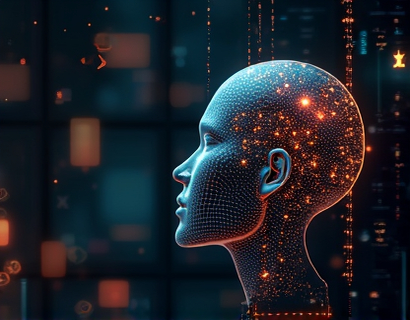AI Chat Avatar: Revolutionizing Digital Interaction with Cutting-Edge Conversational Technology
The digital landscape is rapidly evolving, and at the forefront of this transformation is the emergence of AI chat avatars. These sophisticated entities are redefining how we interact online, offering a blend of intelligence, personality, and adaptability that traditional digital interfaces cannot match. The integration of advanced conversational technology into chat avatars marks a significant leap forward, providing users with a more natural, engaging, and informative experience. This article delves into the world of AI chat avatars, exploring their capabilities, applications, and the profound impact they are having on digital communication.
The Evolution of Digital Interaction
Digital interaction has come a long way since the early days of text-based chat rooms and basic customer service bots. Initially, these interactions were limited by rigid scripts and predefined responses, often leading to a sense of frustration and disconnection. The introduction of AI chat avatars has changed this narrative. These avatars leverage machine learning, natural language processing, and deep learning to understand and generate human-like text and speech. This evolution has not only enhanced user experience but has also opened new avenues for businesses, educators, and content creators to engage with their audiences.
Core Technologies Behind AI Chat Avatars
The foundation of AI chat avatars lies in several key technologies. Natural Language Understanding (NLU) enables the avatar to comprehend user input, discerning intent, context, and emotions. This is crucial for generating relevant and contextually appropriate responses. On the other side, Natural Language Generation (NLG) allows the avatar to craft coherent and natural-sounding text. Together, NLU and NLG form the backbone of effective conversation.
Another critical component is Machine Learning (ML), which powers the avatar's ability to learn from interactions and improve over time. Reinforcement learning, a subset of ML, is particularly useful here, as it allows the avatar to refine its responses based on user feedback and interaction outcomes. Additionally, deep learning techniques, especially neural networks, play a vital role in processing complex patterns in language and behavior, enabling more nuanced and human-like interactions.
Applications of AI Chat Avatars
The applications of AI chat avatars are diverse and far-reaching. In customer service, these avatars provide 24/7 support, handling inquiries, resolving issues, and offering personalized recommendations. This not only enhances customer satisfaction but also reduces the workload on human agents, allowing them to focus on more complex tasks. In education, AI chat avatars serve as interactive tutors, providing explanations, answering questions, and adapting to the learning pace of each student. This personalized approach can significantly improve educational outcomes.
In the realm of entertainment, AI chat avatars are creating immersive experiences in games and virtual reality environments. They can engage players in meaningful dialogues, adapt storylines based on player choices, and even create dynamic NPCs (non-playable characters) that behave realistically. For content creators, these avatars can generate engaging content, manage social media interactions, and even assist in content moderation, streamlining the content creation and management process.
Designing Effective AI Chat Avatars
Designing an effective AI chat avatar involves a multi-faceted approach. First, the avatar's personality and tone must align with the brand or context in which it operates. This includes choosing the right level of formality, humor, and empathy. The avatar's name and visual representation, if applicable, should also resonate with the target audience. Beyond personality, the conversational flow is crucial. The avatar should be able to handle a wide range of topics, transition smoothly between subjects, and maintain context over multiple turns in a conversation.
Technical robustness is another key factor. The avatar must be able to process and respond to user input in real-time, with minimal latency. This requires efficient algorithms and scalable infrastructure to handle high volumes of interactions. Security and privacy are also paramount, ensuring that user data is protected and that interactions are secure. Continuous monitoring and updating of the avatar's knowledge base are essential to keep it relevant and accurate.
Case Study: Interactive Educational Avatar
To illustrate the potential of AI chat avatars, consider an interactive educational avatar designed for a university setting. This avatar, named "EduBot," is integrated into the university's online platform and serves as a primary point of contact for students. EduBot can answer questions about course schedules, provide detailed explanations of complex concepts, and even offer study tips based on the student's performance data. The avatar uses NLU to understand the nuances of student queries and NLG to provide clear, concise answers.
One notable feature of EduBot is its ability to adapt to individual learning styles. By analyzing user interactions, EduBot can tailor its responses to suit visual, auditory, or kinesthetic learners. For example, it might provide video links for visual learners or step-by-step guides for those who prefer hands-on learning. This personalized approach not only enhances the learning experience but also increases student engagement and satisfaction.
Challenges and Future Directions
Despite the significant advancements, AI chat avatars still face several challenges. One major issue is the limitations of current NLU and NLG technologies, which can sometimes lead to misunderstandings or generate awkward responses. Ensuring cultural sensitivity and avoiding biases in the avatar's interactions is another critical concern. Additionally, the integration of multimodal interactions, such as voice and gestures, can significantly enhance the user experience but also adds complexity to the system.
Looking ahead, the future of AI chat avatars is promising. Advances in AI research, particularly in areas like common sense reasoning and emotional intelligence, will make these avatars even more sophisticated. The integration of augmented reality (AR) and virtual reality (VR) will further blur the lines between digital and physical interactions, creating more immersive and interactive experiences. As AI continues to evolve, we can expect chat avatars to become even more intuitive, reliable, and indispensable in our daily digital lives.
Conclusion
AI chat avatars represent a significant leap forward in digital interaction, offering a blend of intelligence, adaptability, and personalization that traditional interfaces cannot match. By leveraging cutting-edge technologies like NLU, NLG, and ML, these avatars are transforming how we communicate online, making interactions more natural, engaging, and informative. Whether in customer service, education, entertainment, or content creation, AI chat avatars are opening new possibilities and enhancing user experiences across various domains. As the technology continues to advance, the potential for AI chat avatars to revolutionize digital interaction is immense, promising a future where conversations with machines feel as natural and meaningful as those with humans.























